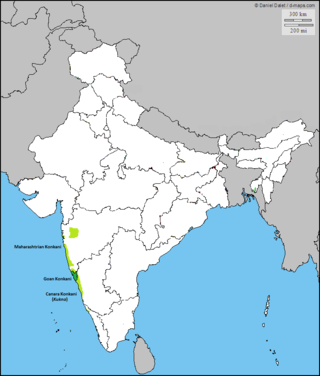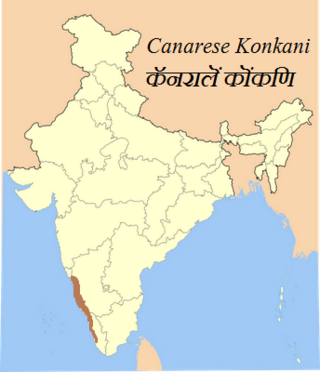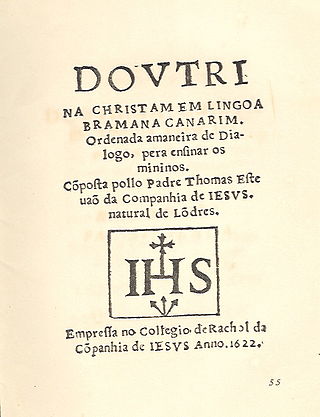
Marathi is an Indo-Aryan language predominantly spoken by Marathi people in the Indian state of Maharashtra. It is the official language of Maharashtra, and additional official language in the state of Goa. It is one of the 22 scheduled languages of India, with 83 million speakers as of 2011. Marathi ranks 13th in the list of languages with most native speakers in the world. Marathi has the third largest number of native speakers in India, after Hindi and Bengali. The language has some of the oldest literature of all modern Indian languages. The major dialects of Marathi are Standard Marathi and the Varhadi dialect.
Indian Script Code for Information Interchange (ISCII) is a coding scheme for representing various writing systems of India. It encodes the main Indic scripts and a Roman transliteration. The supported scripts are: Bengali–Assamese, Devanagari, Gujarati, Gurmukhi, Kannada, Malayalam, Oriya, Tamil, and Telugu. ISCII does not encode the writing systems of India that are based on Persian, but its writing system switching codes nonetheless provide for Kashmiri, Sindhi, Urdu, Persian, Pashto and Arabic. The Persian-based writing systems were subsequently encoded in the PASCII encoding.

Konkani is an Indo-Aryan language spoken by the Konkani people, primarily in the Konkan region, along the western coast of India. It is one of the 22 scheduled languages mentioned in the Indian Constitution, and the official language of the Indian state of Goa. It is also spoken in Karnataka, Maharashtra, Kerala, Gujarat & Daman, Diu & Silvassa.

The Nawayath are an Indian community and a subgroup of Konkani Muslims. They speak the Nawayathi dialect of Konkani.

Konkani Muslims are an ethnoreligious subgroup of the Konkani people of the Konkani region along the west coast of India, who practice Islam. Nawayath Muslims from the North Canara district of Karnataka have similar origin as Konkani Muslims, but show a distinct ethnolinguistic identity due to geographical isolation of the Canara coast from the Konkan coast.
Goans is the demonym used to describe the people native to Goa, India, who form an ethno-linguistic group resulting from the assimilation of Indo-Aryan, Dravidian, Indo-Portuguese, and Austro-Asiatic ethnic and/or linguistic ancestries. They speak different dialects of Konkani language natively, collectively known as Goan Konkani. "Goanese" is an incorrect term for Goans.
Shiroor is a village in Byndoor Taluk in the state of Karnataka, India. Mudramakki, Tuddalli, Keserkodi, Kodmakki and Neerugadde are localities within Shiroor. It is home to the Zamaithi,Nawaithi, Nakhuda, Kannada, Urdu & Konkani.Zamaithi & Nakhuda are languages commonly spoken in the area. Muslim mohalla is the biggest area with nawayathi & zamaithi communities.
Karnataka is a state in the southern part of India. It was created on 1 November 1956, with the passing of the States Reorganisation Act. Karnataka is bordered by the Arabian Sea to the west, Goa to the north-west, Maharashtra to the north, Telangana and Andhra Pradesh to the east, Tamil Nadu to the south-east, and Kerala to the south-west. The state covers an area of 74,122 sq mi (191,976 km2), or 5.83% of the total geographical area of India. It comprises 30 districts. Kannada is the official language of Karnataka and as per the 2011 census is the mother tongue of 66.5% of the population. Various ethnic groups with origins in other parts of India have unique customs and use languages at home other than Kannada, adding to the cultural diversity of the state. Significant linguistic minorities in the state in 2011 included speakers of Urdu (10.8%), Telugu (5.8%), Tamil (3.5%), Marathi (3.4%), Hindi (3.2%), Tulu (2.6%), Konkani (1.3%) and Malayalam (1.3%).
Konkani in the Roman script, commonly known as Romi Konkani or Romi Konknni refers to the writing of the Konkani language in the Roman script. While Konkani is written in five different scripts altogether, Romi Konkani is widely used. Romi Konkani is known to be the oldest preserved and protected literary tradition beginning from the 16th century AD.

Goykānaḍī or Kandavī is a Brahmic script that was once used in the territory of Goa to write Konkani and sometimes Marathi in the Konkan coast. Similarly, it was used by the trading Saraswat and Daivajna families along with the Modi script to maintain their accounts.

Canarese Konkani are a set of dialects spoken by minority Konkani people of the Canara sub-region of Karnataka, and also in Kassergode of Kerala that was part of South Canara. Kanarese script is the primary mode of writing used in Carnatacan Konkani, as recognised by the Konkani Academy.
Konkani is a southern Indo-Aryan language belonging to the Indo-European family of languages spoken in the Konkan coastal region of India. It has approximately 3.6 million speakers.
Konkani alphabets refers to the five different scripts currently used to write the Konkani language.
The Konkani language agitations were a series of protests and demonstrations in India, concerning the uncertain future and the official status of the Konkani language. They were held by Goans in the then union territory of Goa, Daman and Diu governed at the time by the Maharashtrawadi Gomantak Party. The protests involved citizen journalism, student activism and political demonstrations.
Languages spoken in the Indian Subcontinent belong to several language families, the major ones being the Indo-Aryan languages spoken by 75% of Indians and the Dravidian languages spoken by 20% of Indians. Other languages belong to the Austroasiatic, Sino-Tibetan, Tai-Kadai, and a few other minor language families and isolates. India has the world's second-highest number of languages (780), after Papua New Guinea (839). The first known translation of any Christian Scripture in an Indian language was done to Konknni in 1667 AD by Ignacio Arcamone, an Italian Jesuit.
Mavinkurve is a village in the coastal Karnataka in India, located in the Bhatkal taluk of Uttara Kannada district in Karnataka.

Konkani literature is literature in the Konkani language, mostly produced in three scripts: Roman, Devanagari and Kannada. Konkani literature is eligible for the Sahitya Akademi Award

Meitei input methods are the methods that allow users of computers to input texts in the Meitei script, systematically for Meitei language.







